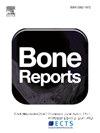Elevated sclerostin levels contribute to reduced bone mineral density in non-ambulatory stroke patients
IF 2.6
Q3 ENDOCRINOLOGY & METABOLISM
引用次数: 0
Abstract
Osteoporosis following stroke is a significant impediment to patient recovery. Decreased mechanical loading and locomotion following the onset of paralysis in stroke patients, especially those who are non-ambulatory, contributes greatly to bone loss. Sclerostin, a protein encoded by the SOST gene, accumulates as a result of reduced mechanical loading and inhibits bone formation. This study explores the relationship between mechanical unloading, sclerostin levels, and bone mineral density (BMD) in stroke patients, utilizing three cohorts. Analysis of Cohort 1, consisting of patients with available sclerostin level measurements, found significantly elevated sclerostin levels in non-ambulatory patients compared to ambulatory patients, indicating the influence of ambulatory status on sclerostin regulation. Cohort 2, consisting of patients with BMD measurements, demonstrated that prolonged mechanical unloading in non-ambulatory patients resulted in a greater decline in BMD over time. Analysis in Cohort 3 patients, who had bilateral BMD measurements available, revealed that hemiplegic sides subjected to reduced mechanical loading exhibited lower BMD compared to non-hemiplegic sides. These findings collectively confirm the hypothesis that reduced mechanical loading elevates sclerostin levels and accelerates bone loss. By integrating data across the three cohorts, this study underscores the critical impact of mechanical unloading on bone health, particularly in chronic stroke patients with limited mobility. Our study provides clinical insights for treatments integrating ambulatory status, sclerostin levels, and BMD in chronic stroke patients and highlights an increased need for therapeutics targeting mechanical loading pathways and sclerostin accumulation which can be administered to treat chronic osteoporosis following stroke.
硬骨蛋白水平升高导致无法行走的中风患者骨质密度降低
中风后骨质疏松症是患者康复的重要障碍。中风患者瘫痪后机械负荷和运动减少,尤其是那些不能走动的患者,对骨质流失有很大的影响。硬化蛋白是一种由SOST基因编码的蛋白质,由于机械负荷减少而积累,并抑制骨形成。本研究利用三个队列探讨脑卒中患者机械卸荷、硬化蛋白水平和骨密度(BMD)之间的关系。队列1的分析,包括可用的硬化蛋白水平测量的患者,发现非门诊患者的硬化蛋白水平明显高于门诊患者,表明门诊状态对硬化蛋白调节的影响。队列2,由骨密度测量的患者组成,证明非门诊患者长时间的机械卸载导致骨密度随时间的更大下降。在队列3患者中,有双侧骨密度测量结果的分析显示,与非偏瘫侧相比,机械负荷减少的偏瘫侧骨密度较低。这些发现共同证实了减少机械负荷会提高硬化蛋白水平并加速骨质流失的假设。通过整合三个队列的数据,本研究强调了机械卸载对骨骼健康的关键影响,特别是对行动能力有限的慢性中风患者。我们的研究为综合动态状态、硬化蛋白水平和慢性脑卒中患者骨密度的治疗提供了临床见解,并强调了对针对机械负荷途径和硬化蛋白积累的治疗方法的需求增加,这些治疗方法可以用于治疗脑卒中后慢性骨质疏松症。
本文章由计算机程序翻译,如有差异,请以英文原文为准。
求助全文
约1分钟内获得全文
求助全文
来源期刊

Bone Reports
Medicine-Orthopedics and Sports Medicine
CiteScore
4.30
自引率
4.00%
发文量
444
审稿时长
57 days
期刊介绍:
Bone Reports is an interdisciplinary forum for the rapid publication of Original Research Articles and Case Reports across basic, translational and clinical aspects of bone and mineral metabolism. The journal publishes papers that are scientifically sound, with the peer review process focused principally on verifying sound methodologies, and correct data analysis and interpretation. We welcome studies either replicating or failing to replicate a previous study, and null findings. We fulfil a critical and current need to enhance research by publishing reproducibility studies and null findings.
 求助内容:
求助内容: 应助结果提醒方式:
应助结果提醒方式:


